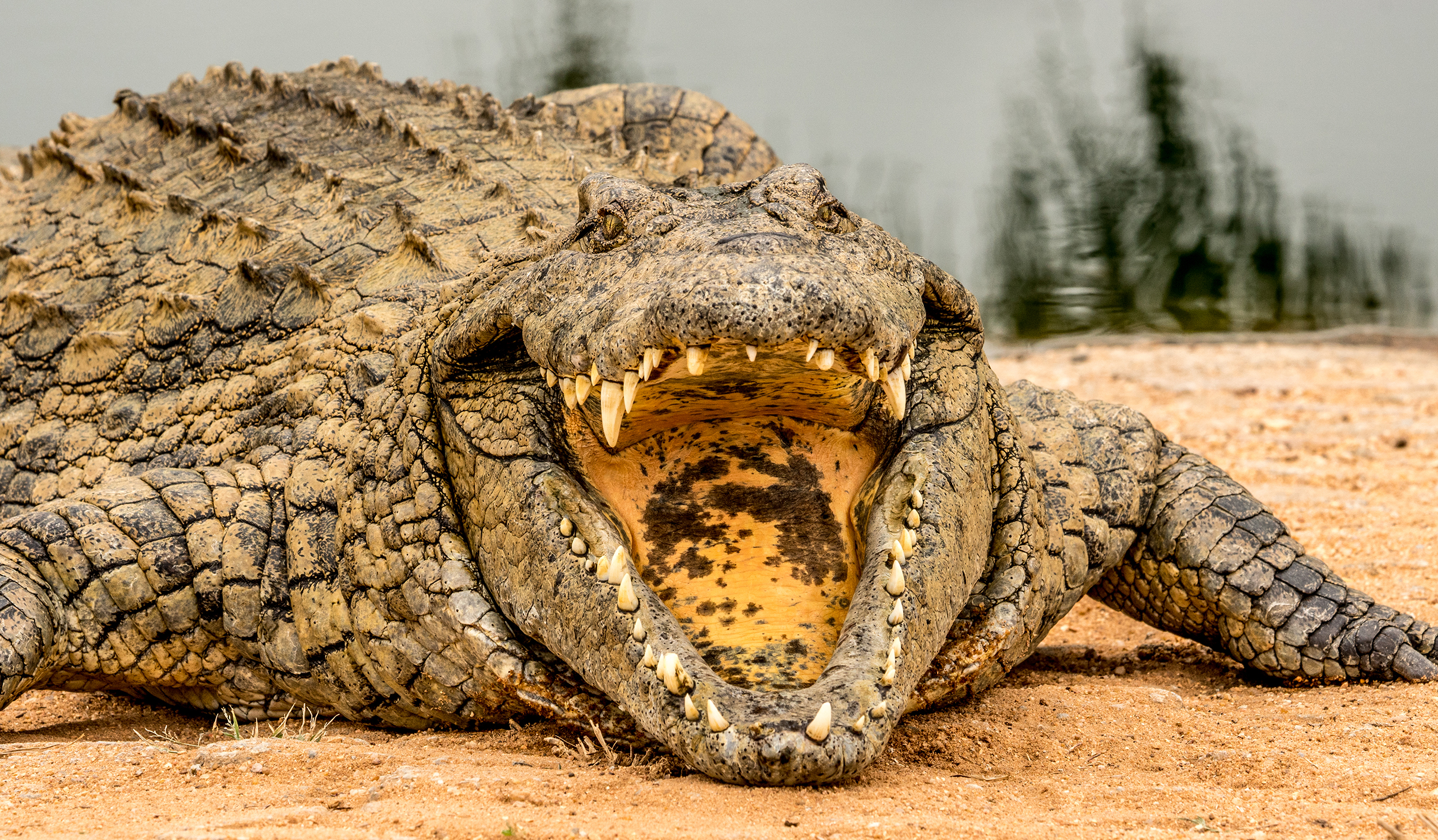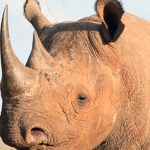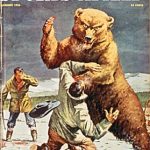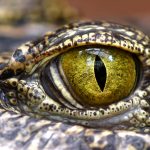The world’s crocodilians have always been a source of fascination and fear.
Hic Sunt Dracones appeared with frequency on the unexplored places on ancient maps: Here Be Dragons. Even with almost every part of the earth now charted, there still be dragons. We call them alligators and crocodiles.
The crocodilians of today have a variety of other names, too, such as caiman, gharial, and mugger. They all descend from crocodylomorpha, evolving more than two hundred thousand millennia ago in the Triassic. The earlier members of the group were far more terrestrial and cursorial than the related reptiles of today, and were among the dominant land animals of the time, overshadowing the dinosaur, until dying out in the aftermath of the mega-volcanic eruptions brought on by the fracturing of the supercontinent Pangea into North and South America, Europe, and Africa some two hundred million years ago. The next iteration of these animals was the Neosuchia, the ancient clade to which modern crocodilians belong.
Our species’ relationship with crocs and gators is more intimate than we may suppose. If you use the evolution-in-one-twenty-four-hour-day model, then on their evolutionary scale, crocodilians first laid their cold eyes on us around a quarter-hour ago. By the time we hominins became persistent carnivores some two million years ago, among our genus’s traits was to settle near water, both for security–mammalian predators couldn’t splash across a creek or pond without alerting all those protohumans clustered around the black obelisk–and food. We had our work cut out in order to feed on terrestrial mammals, but the part vegans omit is that without flesh in our diet, our brains would never have grown as large as they are. (In fact, as we beggared our nutrition by growing and eating crops, our cranial capacity has actually shrunk.) Meat eating lets us tap into a singular suite of lipids–omega-fatty-acid molecules, some in existence for a half billion years–that work industriously on us on the cellular level, in anti-inflammatory, healing, and nerve- and tissue-growth processes, such as encephalization, or brain building. If “omega fatty acids” rings a bell, it is because, as we know now, aquatic animals such as fish, turtles, and even crocodiles, are rich in them. And living beside water, we had them right there at our back door, able to take them without having to compete with lions, leopards, or hyenas.
Our existence in Africa as hominins, though, overlapped with that of some crocodilians that grew to more than thirty feet in length. So our food could often make us its food, without shedding a tear. No one questions the danger of crocodilians today. Around the tropical world, “Don’t go near the water” is an endemic, if not ubiquitous, caution.
As an example of the warning, persistent to this day, a teacher being rowed to a mission school on Lake Nyasa (now Malawi) in the 1910s could not resist gliding her hand in the water.
“Ngwena, Dona!” one of the oarsman called out. “Crocodile, Madame!”
Among the more than two dozen different species of crocodilians, thirteen are known man-eaters–or killers, the mugger of Iran and India often attacking without eating—with Nile and saltwater crocodiles the two most deadly. Globally they may be responsible for a thousand human deaths per year. And another seven species are implicated in non-fatal attacks. For good reason, then, they have been held in terror and awe not just in recorded history, but throughout time.
Perhaps most notably, the ancient Egyptians both feared and worshipped the crocodile in the form of the god Sobek, crocodiles being mummified in adoration of him. Tomb walls depicted herdsmen casting spells to protect them and their livestock when they rafted across the Nile. Centuries later, Shakespeare was shaky on the origin of crocodiles themselves: in Antony and Cleopatra he had Lepidus, one of the triumvir who governed Rome after the assassination of Julius Caesar, say that they are grown by the sun from the mud of the Nile.
In something between adoration and dread, there was a ritual of hanging stuffed crocodiles from the rafters and on the walls of medieval churches and cathedrals throughout Europe. Most of these seem to have been brought back as skins or live specimens by Crusaders returning from the Holy Land and North Africa. They were placed as ex voto offerings in thanks for heavenly intercession. They also might represent evil or Satan, so there was the symbolism of the Devil bound in chains. Because of the unique durability of their hides, they have been preserved to this day, to startle unwitting tourists looking up into the vaulted ceilings.
Writing in his authoritative Description of Africa, the sixteenth-century Andalusian-Berber merchant, traveler, and diplomat Joannes Leo Africanus told of other displays of dead crocodiles. From the 1600 translation of his 1550 book:
“Of these beasts I sawe above three hundred heads placed upon the wals of Cana [a formerly major city in what is now Benin], with their jawes wide open, being of so monstrous and incredible a bignes, that they were sufficient to have swallowed up a whole cowe at once, and their teeth were great and sharpe.”
Africanus had no doubt about the crocodile’s being a “cruell and noisome beast.” It “containeth in length twelve cubites and above”–not hyperbole for the outsized length of an exceptional Nile crocodile–“the taile thereof being as long as the whole bodie besides, albeit there are but fewe of so huge a bignes.” Africanus claimed witnessing a traveling companion swept one night into a river by the swipe of the tail of a crocodile and lost in the darkness.
Africanus’s friend may have lived just long enough to experience the initial stages of the crocodilian’s method of making a kill, seemingly coming down from the Antediluvian: the death roll. If crocodilians can swallow a prey animal whole, that’s what they do. If not, they clasp the body in their jaws and twist over and over to tear out portions of skin, flesh, and bone. This is also the crocodilian’s signature move when wrestling other crocodilians who are tough enough, generally, to withstand it, though sometimes at the cost of a limb or two. With prey, crocodilians might also bash them against river banks and bottoms or against rocks, though they are also known to cache their kills to let them ripen. Even moderately sized crocodilians are big enough to grab, hold, and drown a human.
In recent history, the cruelty and noisomeness of the crocodile is seen in a tale from World War II. You remember Quint’s speech on the boat at sea at night in Jaws, about the shark attack on the U. S. S. Indianapolis’s crew after it abandoned ship. That same year, the British sent troops of the Indian Army to retake Ramree Island off the coast of Burma, now Myanmar. The attack drove nine hundred Japanese, who had offered fierce resistance, into retreat through mangrove swamps that were the habitat of enormous estuarine, or saltwater, crocodiles. Stories of random rifle fire in the night, human screams, and sounds of violent feeding, were bruited about. It was said that five hundred Japanese never came out, eaten alive. Later investigation casts doubt on this; but even if the toll were only in the dozens, which seems plausible, it remains the single largest fatal crocodile attack in history.
In the 1960s, Nile crocodiles seemed to develop a partiality for idealistic and oblivious Peace Corp volunteers. In one notorious incident, when a new group arrived on the Baro River in southwestern Ethiopia on a hot day in 1966, they decided a picnic and a cooling dip were in order. As they splashed about, one young man swam across to the tail of a sandbar. As his friends watched, he stood, then disappeared.
“We saw the tip of the nose of the crocodile,” wrote one of the fellow volunteers, “[and] it looked like Bill said something, and then he was gone. There was no struggle; he never knew what hit him.”
The crocodile was found and killed, and the human body parts collected–in particular the precisely severed bare lower legs–placed in a cardboard box, and flown out.
“I have never heard of a crocodile hunter,” wrote the professional African hide hunter Paul Potous in the mid-1950s, in his book, No Tears for the Crocodile, “having been taken by a crocodile. But,” he added, “there is always a first time to everything.”
Though crocodilians would seem to pose no direct threat to armed hunters, unless they were to go into the water after them, they present no small challenge as big game. On the whole, crocodilians take up residence in the deepest, darkest, thickest, muddiest, most-hard-to-reach places. On top of that, as Potous writes:
“Their sense of smell, hearing, and eyesight are all exceptionally keen, and there is yet another inexplicable instinct with which they are endowed–awareness of danger. Also to their advantage and protection are the movements and warning noises of the numerous birds, a wonderful variety of which are found along the African rivers [and in the habitats of other crocodilians].”
We have probably no adequate idea of how astronomically high the global population of crocodilians may once have been, even in recorded times. Exploring Florida and other parts of the Southeast just before the War of Independence, the Philadelphia botanist William Bartram wrote in his Travels:
“How shall I express myself so as to convey an adequate idea of it to the reader, and at the same time avoid raising suspicions of my veracity? Should I say, that the river (in this place) from shore to shore, and perhaps near half a mile above and below me, appeared to be one solid bank of fish, of various kinds [largely black bass], pushing through this narrow pass of the St. Juan’s [St. Johns River] into the little lake, on their return down the river, and that the alligators were in such incredible numbers, and so close together from shore to shore, that it would have been easy to have walked across on their heads, had the animals been harmless?”
With vast numbers came great size. From the Louisiana family that to this day owns the salt-dome Avery Island in Iberia Parish, seventeen-year-old “Ned” McIlhenny set out on the day after New Year’s, 1890, in a lugger–a small sailing ship–with two helpers, to wind through the bayou to Vermillion Bay to hunt geese. Across the bay at dusk, Ned crossed the silted mouth of Lake Cock on foot, and followed the bank of an old stream to hunt ducks for supper. Wading into the marsh to retrieve two mallards he had dropped, he saw what he thought to be a submerged log, which showed itself to be an enormous alligator, stupefied by the cold. With only a shotgun and shot shells, Ned killed the animal. He left it for the night, suspecting this was the largest gator he had ever seen. When the three men returned in the morning, and were unable to drag the alligator out, Ned used the thirty-inch barrel of his gun and arrived at 7⅔ lengths, or 19 feet, 2 inches. Ned went on to become the country’s foremost authority on alligators, with remarkably few questioning his report of the near-miraculous size of the monstrous gator (a certified 15-foot, 9-inch one was killed in Alabama in 2014). The McIlhenny’s famed product, Tabasco, remains an essential ingredient in that indispensable Cajun dish, alligator sauce piquante.
The largest crocodilians on earth today are the estuarine crocodiles, or “salties,” of Australia, and ranging across the Indo-Pacific from Sri Lanka and Kanyakumari at the tip of India, to the Solomon Islands. The largest ever reliably measured in captivity was one captured in the Philippines in 2011 (it was given a name, but there is something patronizing and infantilizing about calling any wild animal Shamu or Elsa, so I won’t repeat it here). It was 20 feet, 3 inches long and weighed more than 2,000 pounds. It died two years later of a heart ailment at age fifty. Crocodiles can live to seventy-five, and up to a hundred in zoos, and they grow throughout their lives, so the question is: how much bigger might it have become?
The biggest crocodilian ever killed? It would have been, again, a saltie. The only evidence, though, is a grainy black-and-white photo taken in 1914 on the bank of the Roper River that flows out of northern Australia into the Gulf of Carpentaria. The hunter was the missionary Rev. R. D. Joynt, photographed with a well-dressed “Miss Cross”–no further identification–crouched behind a crocodile said unblushingly to be 28 feet long. Though it is likely not nearly that big, and even allowing for the carcass being swollen in the hot sun and the benefit of forced perspective, it is nonetheless one hell of a croc.
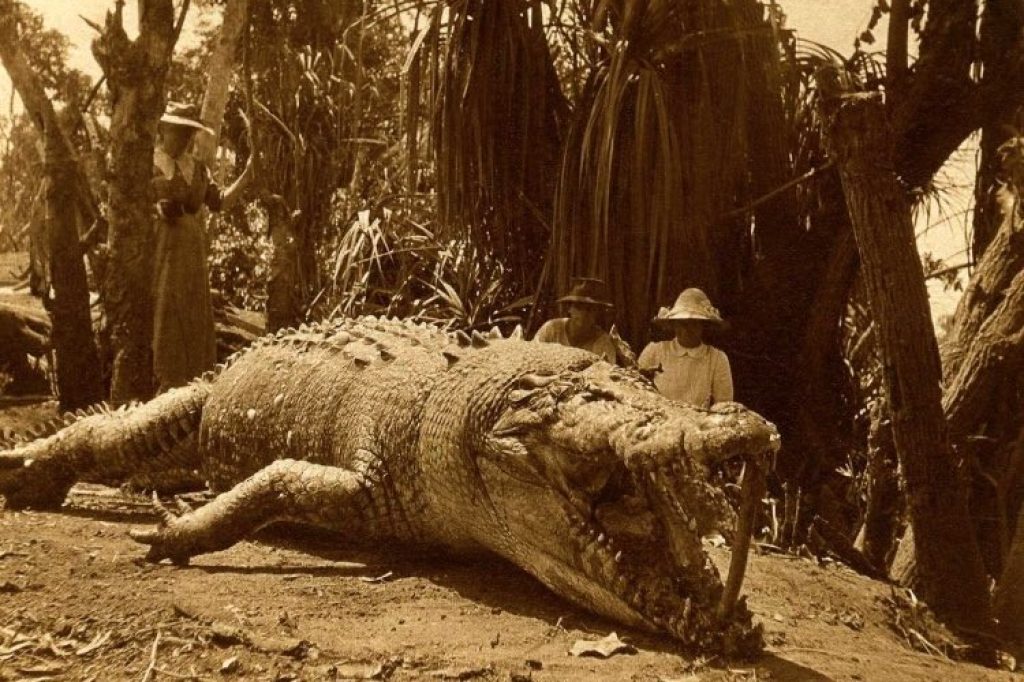
The twentieth century was a close shave for numerous species of crocodilians. In many parts of the world, bureaucracies tended to consider crocodilians no more than a nuisance. In colonial Africa there were C. D. O.s–Crocodile Destruction Officers–usually some old retiree who’d putter around on a lake with a fishing resource, chunking out chicken-egg-size doses of potassium cyanide sewn inside rotten pieces of baboons, monkeys, fish, hippos, even the meat from poisoned crocs. Crocodile eats. Crocodile disappears. Crocodile dies. Crocodile putrefies. Crocodile floats up. Crocodile is of no use to anyone, not even as a hide, although other crocs might consume it, thus possibly resuming the cycle.
Generally considered inferior leather at the time, tanned crocodile skins went back and forth in popularity throughout the 1800s. It was in the early 1900s when tanners learned to make a durable, pliable, commercial product and fashion houses turned it into a luxury item, and the wholesale slaughter was underway.
Among the most famous crocodile market hunters in Australia was an emigre from World War II Poland, Krystyna Pawłowska. She and her fellow Polish-emigre husband entered the saltie business when one tried to eat their toddler daughter in 1955 when they were gold prospecting in Queensland. The three-year-old was taking a bath on the bank of a river when a croc came out of the water and began stalking her. Seeing the croc, her brother yelled to his sister, and her father came out with a rifle and killed it. They decided to sell the skin and were surprised when it brought them £A10, over $360 USD today. At the time, the average weekly wage in Australia was $470.
When her husband’s partner quit, Krys began hunting with him. She proved to be an excellent shot, never wading into the muddy rivers to hunt without lipstick and nail polish, and over the next decade is said to have taken at least 5,000 crocodiles, missing only three. Just as impressive was her reputation of being able to skin, flesh, salt, and roll a hide faster than anyone else. In the mid-1960s, the Pawłowskas figured they’d killed their fair share of salties and opened Australia’s first crocodile farm. Oh, and in 1957, Krys killed a croc in the Norman River that was said to equal the one from the Roper forty-three years before. With as much hard evidence.
Maybe not the greatest crocodile hunter of all time, but certainly the most colorful, was the famed photographer and Afrophile Peter Beard. Because of concerns in the mid-1960s about the population, Alistair Graham, a zoologist, was contracted by the Kenyan government to spend a year on the fly-blown shore of isolated Lake Turkana, surveying Africa’s largest remaining Nile crocodile population. Beard came along with his camera and rifle.
Caking themselves in mud, the two floated out on inner tubes to the crocs. When hunting at night, they targeted the eyeshine they detected in their flashlight beams. Overall, they shot, skinned, and necropsied just shy of 500 in the year, living off Nile perch, some weighing nearly two hundred pounds, that were either speared or killed with a .357 Magnum pistol in the shallows. Beard’s teeth turned brown from drinking the lake’s alkaline water. His collaboration with Graham resulted in the classic Eyelids of Morning.
The American alligator was listed as endangered in 1967–controversy remains about whether the classification was ever really biologically justified–and delisted at the end of the 1970s, and it now numbers in the millions across its range. Australia outlawed saltwater-crocodile hunting in 1971. Today there are well over a hundred thousand, with a flourishing population of feral pigs to feed on, and all the ranchers’ cattle they can eat, until they get shot as “problem” animals. Salties are today probably back at the carrying capacity of the habitat, but there are no opportunities for international hunters to take them. Locals and Aboriginal people would love to take you hunting, and there some limited permits to be had, but only the Aussie permit holder can take the croc. Despite their numbers and the problems they can cause for locals, saltwater crocs in Australia are not currently huntable by foreign hunters.
Without resorting to shark hooks and seine lines, which moves the pursuit into the realm of angling, crocodilians are among the most challenging big game to hunt. Then there is the fact you can eat, wear, and mount them on the wall. There are also few more magnificent animals in creation.
Paul Potous made a statement that, while rather stupid, gives his book its title. He tells us that “no one can be cruel to a crocodile. Repulsive and loathsome, it is held in abject fear by the natives . . . Men, women or children–they are all a meal to the saurian. In hunting it, I should still have the excitement of the chase, but at its death there would be no tears for the crocodile.”
Peter Beard’s Eyelids photographs were gleefully erotic, outrageous, and grotesque, yet with something quaking about them. One is now riding on a golden record across interstellar space aboard the N. A. S. A. Voyager probe, so the only end to the journey of the image of a crocodile is the span of the universe.
The late Tom McIntyre’s book, Thunder Without Rain, will be published this year by Skyhorse Publishing.

